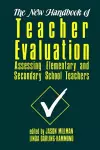
The New Handbook of Teacher Evaluation
2 authors - Paperback
£37.99
ITHACA, N.Y. -- Jason Millman, a Cornell University professor of education and an expert on standardized testing methods, died Feb. 22 in Lake Oswego, Ore., where he was visiting family. He died from complications arising from Shy-Drager Syndrome. He was 64. Millman spent a large part of his career studying standardized testing of high school and college students, developing evaluation guidelines for teachers and trying to find accurate ways to measure human performance in an academic setting. In 1992, Millman was commissioned by the New York State Court of Appeals to study whether the New York Bar examination was biased. In his study, released in May 1993, Millman concluded that although passing rates differed across groups, the bar examination was not biased. Later, in a 1994 study on testing accommodations, he developed a methodology for investigating whether the completion of tasks within a prescribed amount of time is an important lawyering skill. Millman also studied the appropriate use of the Scholastic Aptitude Test and was critical of states that compared schools to each other through a "pervasive, simplistic, misleading and dangerous" use of scores. The SAT, he claimed, is taken by motivated, college-bound students and is designed to predict how individual students will perform in college, not to measure schools′ effectiveness. In addition to evaluating the performance of students and teachers on standardized tests, Millman and his colleagues also published a 1983 study in the journal Research in Higher Education, indicating that grade inflation was threatening the reliability and validity of grade-point averages. Millman served as co-editor, with Linda Darling-Hammond, of The New Handbook for Teacher Evaluation: Assessing Elementary and Secondary School Teachers (1990), a popular book in the education field. His other books included Grading Teachers, Grading Schools: Is Student Achievement a Valid Evaluation Measure? (1997) and How to Take Tests (1969). He also served as editor of two professional journals, Education Researcher (1964-68) and Journal of Education Measurement (1968-71). Millman grew up in Albany, N.Y., and graduated from Albany High School in 1951. He earned a bachelor′s degree in mathematics education in 1955 and a doctorate in psychometrics in 1960, both from the University of Michigan. He joined the Cornell faculty in 1960 as an assistant professor, teaching educational research methodology. He was named a professor in 1969. He served as president of the National Council on Measurement in Education (1978-81) and president of the Educational Research Association of New York State (1963-64). He held elective offices with the Measurement and Research Methodology Division, American Research Association. He served a four-year term as an executive committee member of the National Assessment Governing Board. In 1996 he was awarded the National Council on Measurement in Education Career Award. In addition to his academic accomplishments, he was active in the Suicide Prevention and Crisis Service in Tompkins County, N.Y. He was a writer of the handbook Talking With the Callers: Guidelines for Crisis Line and Other Volunteer Counselors (1998). Millman lived in Ithaca and is survived by his wife, Meredith; sons Jeffrey of San Francisco, Almar of Oswego Lake, Ore., and David of Ithaca; five grandchildren; a brother, Russell Millman of Cincinnati; and a sister, Miriam Biglow of Palm Harbor, Fla. Linda Darling-Hammond is Charles E. Ducommun Professor of Education at Stanford University where she has launched the Stanford Educational Leadership Institute and the School Redesign Network. She has also served as faculty sponsor for the Stanford Teacher Education Program. She is a former president of the American Educational Research Association and member of the National Academy of Education. Her research, teaching, and policy work focus on issues of school restructuring, teacher quality and educational equity. From 1994-2001, she served as executive director of the National Commission on Teaching and America’s Future, a blue-ribbon panel whose 1996 report, What Matters Most: Teaching for America’s Future, led to sweeping policy changes affecting teaching and teacher education. In 2006, this report was named one of the most influential affecting U.S. education and Darling-Hammond was named one of the nation’s ten most influential people affecting educational policy over the last decade. Among Darling-Hammond’s more than 300 publications are Preparing Teachers for a Changing World: What Teachers Should Learn and be Able to Do (with John Bransford, for the National Academy of Education, winner of the Pomeroy Award from AACTE), Teaching as the Learning Profession: A Handbook of Policy and Practice (Jossey-Bass: 1999) (co-edited with Gary Sykes), which received the National Staff Development Council’s Outstanding Book Award for 2000; and The Right to Learn: A Blueprint for Schools that Work, recipient of the American Educational Research Association’s Outstanding Book Award for 1998.